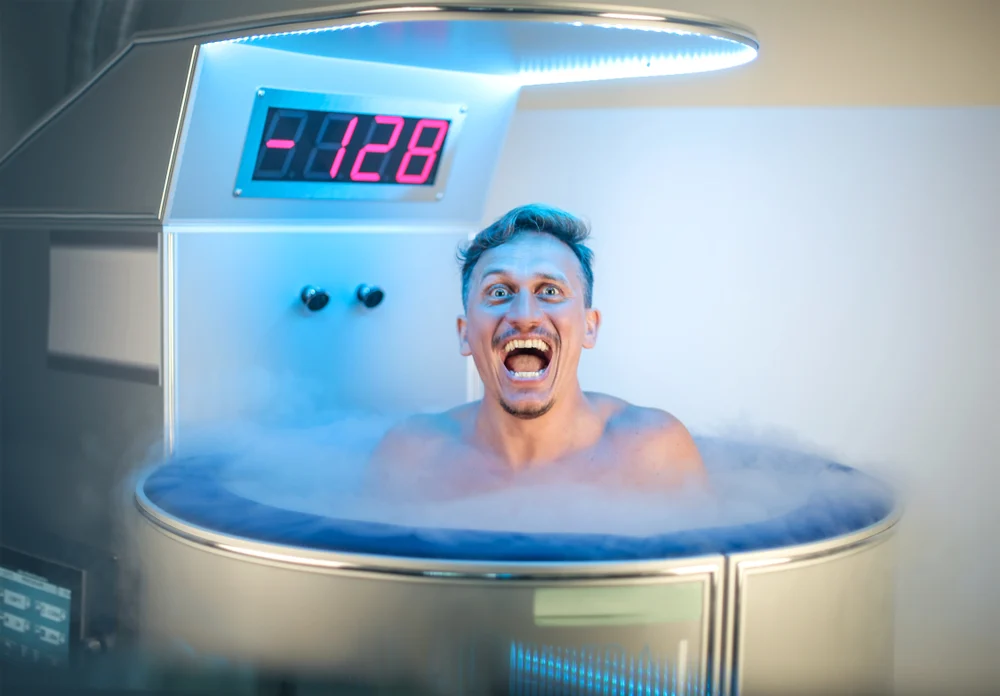
After a hard workout, most people feel at least a few aches and pains. This is especially true for athletes as they age. Who hasn’t felt more aches and pains at 40 than they did at 20? Giving your body time to heal from aches and pains is why rest and recovery is an important part of any fitness regimen. But maybe you want to speed up your recovery, and maybe you’ve heard of whole body cryotherapy as an option. If so, you might want to think twice before trying it. Read on to learn more.
What is whole body cryotherapy?
Whole body cryotherapy involves placing your entire body in super-low temperatures of between minus 200 to minus 300 degrees Fahrenheit for about three minutes at a time. Some devices are made for use by one person. In these devices, the person stands in a tube with an open top that leaves their head poking out the opening. Other devices are made for more than one person. These devices resemble a closet or a small room and have ultra-cooled liquid nitrogen circulating through them.
Many high-profile people have promoted the use the whole body cryotherapy. These include such celebrities as Justin Timberlake, Jennifer Aniston, and LeBron James. However, it should be noted that the use of whole body cryotherapy by famous people does not mean it’s safe or wise, it just means it’s popular.
Where can you have whole body cryotherapy?
Many spas, gyms, and wellness centers offer whole body cryotherapy. These providers often claim that whole body cryotherapy can help with painful physical conditions, such as rheumatoid arthritis, fibromyalgia, multiple sclerosis, and migraines. Some providers also claim whole body cryotherapy can help with stress, anxiety, depression, or other mental health conditions. The truthfulness of these claims is up for debate, however.
What are the dangers of whole body cryotherapy?
The FDA has issued a warning about whole body cryotherapy to alert people to the fact that this technique is not approved as a treatment for any condition. This advisory explains that the claims about the benefits of whole body cryotherapy have not been proven by any reputable research, and it also points out that there are risks involved in whole body cryotherapy, including potential problems with heart rate, blood pressure, and metabolism. Other risks include the dangers of asphyxiation, frostbite, burns, and injuries to the eyes from the extreme cold.
Another group warning about the dangers of whole body cryotherapy is the American Academy of Dermatology (AAD). In addition to frostbite, the AAD notes that whole body cryotherapy can cause frozen limbs and a rash that covers the whole body. As a result, this medical association recommends nobody try whole body cryotherapy.
What other cryotherapy options are there?
If whole body cryotherapy is risky and should be avoided, what other cryotherapy options are there? Ice baths are one. This involves dunking the entire body into an icy cold bath of water. While this process might sound similar to whole body cryotherapy, the temperatures involved in an ice bath are not as extreme. Still, anyone with a heart condition or other health concern should check with a doctor first.
Another option is to use a simple ice pack. Several research studies have shown that the traditional ice pack is effective at reducing pain and swelling. Usual treatment calls for about 15-20 minutes of icing after an injury.
It should be noted that some studies discourage the use of ice except for an acute injury. These studies have shown that if a muscle is sore rather than injured, icing does not lead to less pain. These studies also showed that using ice can reduce muscle strength, power, and coordination. This means that after icing, athletes jumped lower, ran slower, and threw shorter distances. These findings suggest that icing should only be used after an injury rather than on a routine basis.
What other uses are there for cryotherapy?
Although whole body cryotherapy is discouraged, cryotherapy does have approved medical uses. In these cases, extremely cold temperatures are used to destroy diseased tissues. For example, cryotherapy has been used successfully to treat cancers, such as bone, cervical, liver, prostate, and skin cancer. Cryotherapy is also used by dermatologists to remove non-cancerous warts, skin tags, and dark spots. In such cases, cryotherapy can be applied either externally or internally through a small incision.
Although these uses of cryotherapy are medically approved, as with most medical procedures, there can be risks involved. These include bleeding, cramping, nerve damage, swelling, scarring, and infection. In most cases, the potential benefits of removing diseased tissue outweigh the chances of experiencing an adverse effect. However, cryotherapy should always be undertaken by a trained medical professional and only after careful consideration of both the benefits and risks involved.
